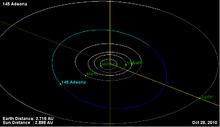Discovery date 3 June 1875 Discovered 3 June 1875 Asteroid family Adeona family | Observation arc 130.60 yr (47700 d) Orbits Sun Named after Adeona | |
 | ||
Minor planet category Main belt, adeona family Aphelion 3.05972 AU (457.728 Gm) Perihelion 2.28737 AU (342.186 Gm) Discoverer Christian Heinrich Friedrich Peters Similar 135 Hertha, 165 Loreley, 196 Philomela, 188 Menippe, Asteroid belt | ||
145 Adeona is a rather large main-belt asteroid. Its surface is very dark, and, based upon its classification as a C-type asteroid, is probably composed of primitive carbonaceous material. The Adeona family of asteroids is named after it.
It was discovered by C. H. F. Peters on June 3, 1875, from the observatory at Hamilton College, Clinton, New York. Peters named it after Adeona, the Roman goddess of homecoming, because he had recently returned from a journey across the world to observe the transit of Venus. Peters also discovered 144 Vibilia on the same night.
During 2001, 145 Adeona was observed by radar from the Arecibo Observatory. The return signal matched an effective diameter of 151 ± 18 km. This is consistent with the asteroid dimensions computed through other means.
Adeona has been observed to occult a star once, on July 9, 2002.
The Dawn mission team discussed performing a flyby of this object, however NASA decided against it in July 2016. At the time this was considered Dawn was orbiting the large asteroid/dwarf planet 1 Ceres, and went on studying that body later that year. Dawn had previously orbited that asteroid 4 Vesta, before traveling to Ceres. Its use of solar-powered ion engines allowed it have a large change in velocity for less propellant than if it used the chemical propulsion of this period
